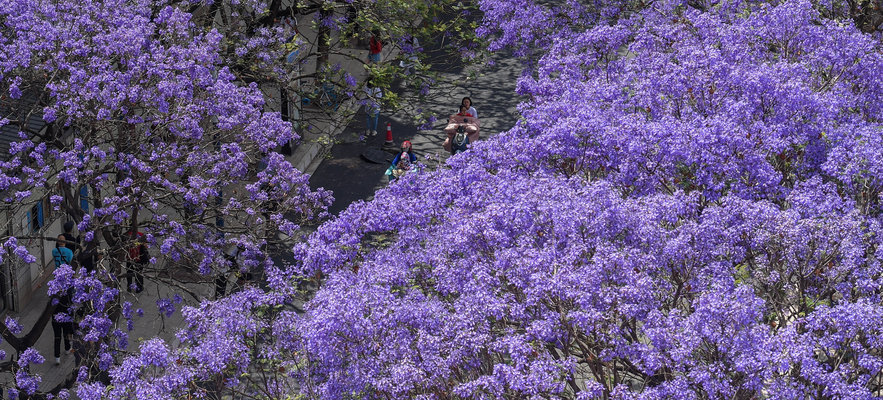At the end of spring and beginning of summer, which is normally from the end of April until halfway May in Kunming, jacaranda flowers in the Spring city are in full bloom. Tourists and locals gather around the streets to appreciate these purple flower canopies at Green Lake Park, Beijing Road, Huanhu Road and Jiaochang Middle Road. Among the numerous flower-viewing-spots, Jiaochang Middle Road (教场中路) is the most spectacular. There are hundreds of jacaranda trees lining both sides of Jiaochang Middle Road, and walking along the road is walking under a purple cloud, and that’s why it is also known as “Jacaranda Avenue”. Every year, this beautiful scenery attracts lots of tourists and photographers, and this year is no exception.
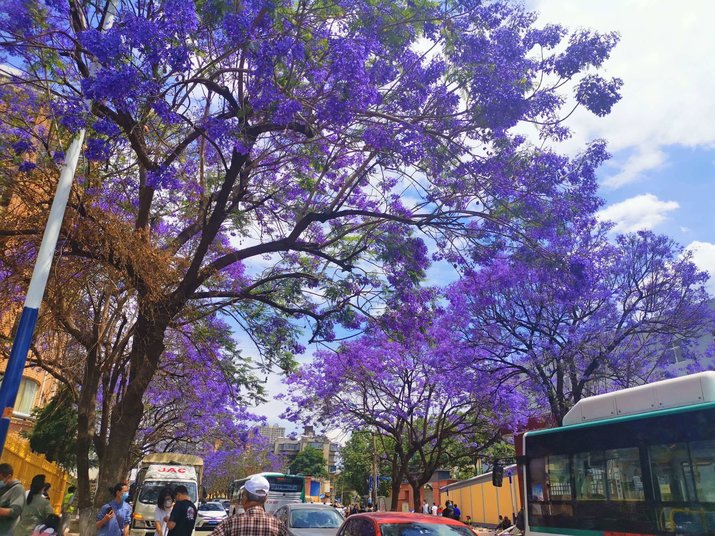 Jiaochang Middle Road- Jacaranda Avenue
Jiaochang Middle Road- Jacaranda Avenue
This year, there’s not only the blue-purple sea of flowers in full bloom to be enjoyed in Kunming, but there are also newly added murals with the Jacaranda sceneries and elements in the area, as well as some creative products which are developed by the government to promote tourism, such as scarves and ice creams with designs of Jacaranda flowers.

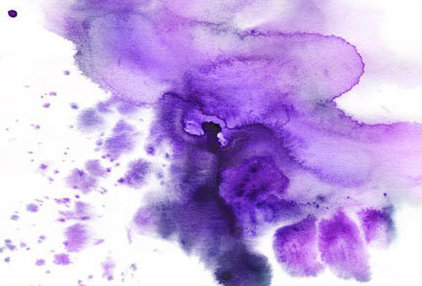 (left) Ice Cream in the shape of Jacaranda flowers (right) Silk scarf pattern of Jacaranda flowers
(left) Ice Cream in the shape of Jacaranda flowers (right) Silk scarf pattern of Jacaranda flowers
Origin
The Jacaranda genus is native to the subtropical and tropical regions of South America, and the genus has around 50 species. Nowadays the tree can be found all over the world where there are no long frost periods. Mature trees can survive a few days of temperatures just below zero degrees Celcius, but younger trees will suffer damage. The most common species found is the Blue Jacaranda (Jacaranda mimosifolia) and you can find it everywhere in the world lining streets and public places.
The Blue Jacaranda trees can grow up to 20 meters tall. The purple trumpet-shaped flowers are about 5 cm long and are grouped in clusters that are up to 30 cm long. After the bloom, a woody seed pod appears that contains flat, winged seeds. In several cultures, the seeds are gathered and used as decoration.
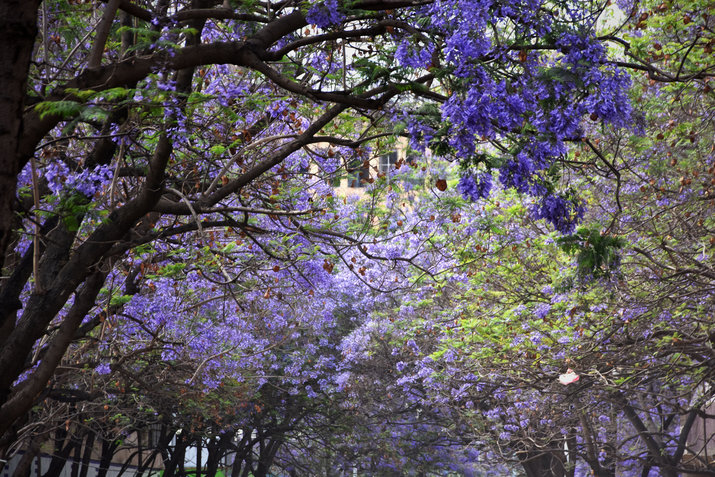 Jacaranda canopy in Jiaocheng Middle Road, Kunming, Yunnan, China
Jacaranda canopy in Jiaocheng Middle Road, Kunming, Yunnan, China
Symbolism
Many flowers have their own special meaning and symbolism around the world, so does jacaranda flower. The jacaranda flowers symbolize different things in different cultures, but often represents peace, profoundness, rebirth, wealth and luck. It also has a meaning of melancholy for some, particularly waiting for love in despair and feeling proud even in defeat.
It is said in some countries, including the USA, that when a jacaranda flower falls on your head, you will have good luck. In Australia, when a purple flower falls on the head of a student, the student will pass the exams.
Because of the intense flowers and increasing popularity, the jacaranda flowers have many different cultural and local meaning.
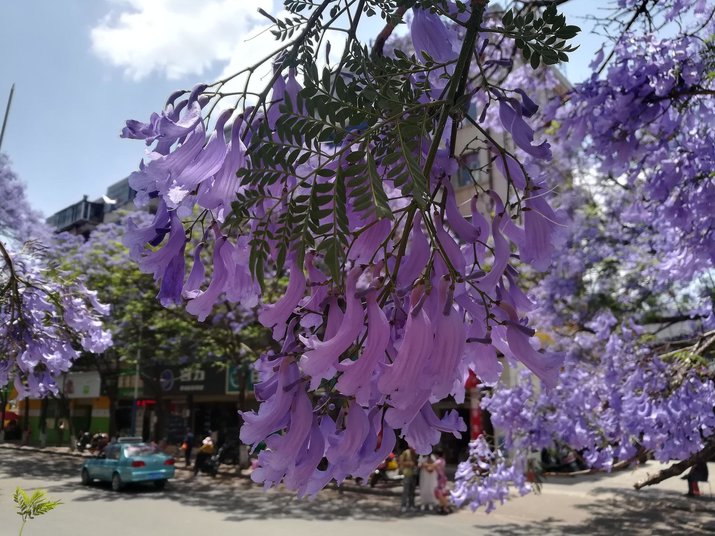 Jacaranda Mimosifolia in Kunming
Jacaranda Mimosifolia in Kunming
1. Amazon: the Daughter of the Moon legend
In the native habitat of the jacaranda in the Amazon, there is a legend that a beautiful bird called Mitu landed on a Jacaranda tree. The bird had brought a beautiful priestess with it, she was called the Daughter of the Moon. She descended from the tree and joined the villagers living around the tree. She shared her knowledge, wisdom and ethics wit them, teaching them about good and evil. She eventually felt like she had fulfilled her mission, and returned to the blooming jacaranda tree. She climbed up the tree and ascended back to the heavens to be united with her soul mate again, the Son of the Sun.
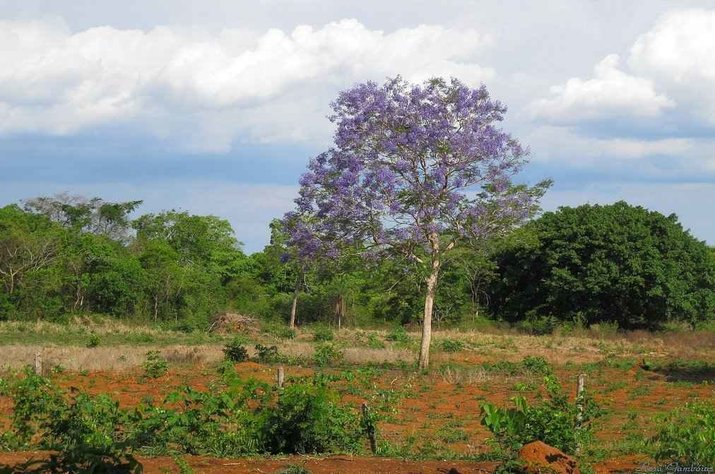 Wild Jacaranda Mimosifolia in Brazil
Wild Jacaranda Mimosifolia in Brazil
2. South Africa: the enchanting invader
The capital of South Africa Pretoria is honoured as “Jacaranda City”. When spring comes at the end of October, the blooming jacaranda flowers turn the whole city lilac and the view is absolutely stunning. The trees were imported from Brazil in the 1880s and since then over 50.000 trees have been planted all over the city. The Jacaranda City is also often used in Southern African songs.
There is a darker side to this otherworldly Jacaranda City though. The Jacaranda tree, beautiful and enchanting as it is, is an invasive species that is a threat to the local vegetation. The root system is extensive and the tree needs a lot of water to grow, preventing anything else from growing around them. There have been many debates whether chop the trees down, but locals fought for the trees and in the end, it was decided no new trees can be planted.
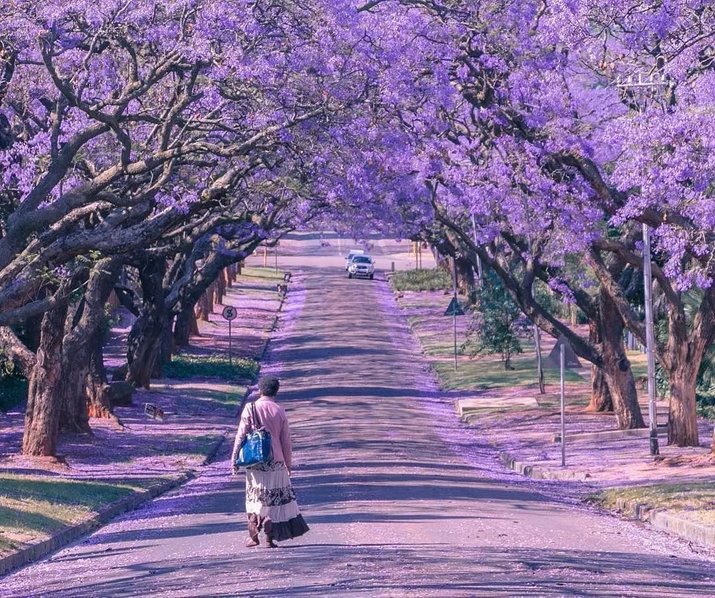 Jacarandas lining a street in South Africa's Pretoria
Jacarandas lining a street in South Africa's Pretoria
3. Australia: Christmas is coming
You can find the purple canopies of jacaranda in many cities down under and the tree has been growing there for over 150 years. During the blooming period, the green fern-like leaves will gradually fall off, and the branches will be full of dark blue flowers. In Australia, the jacaranda blossoms symbolize the coming of Christmas, as they start blooming in November when it is spring in the southern hemisphere.
Some people have been sceptical, as after the blooming period, mostly empty twigs are left, leaving little leaves and flowers to provide shadow in the hot sizzling summer of Australia. But for most Aussies, that doesn’t weight up against the joy this beautiful tree brings to the people every spring.
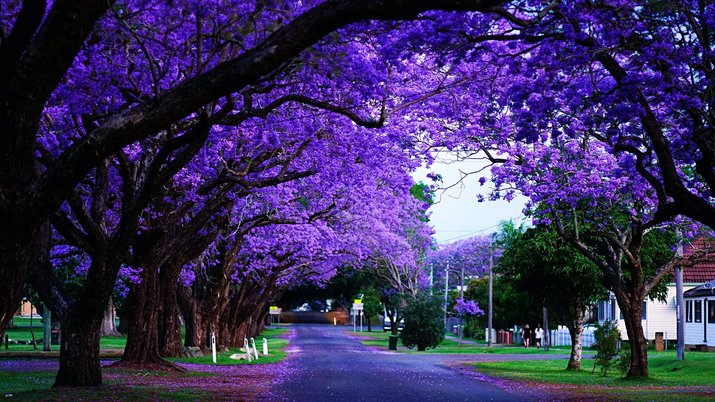 Jacaranda street in Australia
Jacaranda street in Australia
4. USA: a love-hate relationship
In the southern regions of the USA such as California, Texas, Arizona and Florida, Jacarandas are grown extensively. The trees were brought to the USA in the 1860s and in 2010 there were about 148,500 trees in LA only. Praised by tourists, photographers and flower lovers equally for obvious reasons; the tree is absolutely stunning and the deep intense purple colour seems to touch many people’s hearts. But not everyone’s. People who enthusiastically planted a jacaranda tree in their front yard often decide later to chop it down. Why would you chop down this purple splendor? Turns out, after the jacaranda finished blooming for a few weeks, these lovely purple flowers will all fall off and create a sticky and murky-smelling mess on the sidewalk, your patio, your yard and your car.
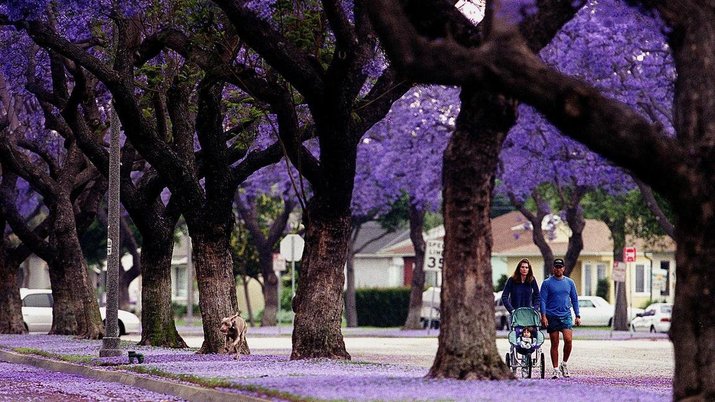 These beautiful trees, unfortunately, leave a mess behind that is hard to clean up
These beautiful trees, unfortunately, leave a mess behind that is hard to clean up
5. Argentina: The Huge Tree
Jacarandas are also planted in a few areas in Argentina. The local area is very suitable for growing jacarandas due to the subtropical climate. When the jacarandas are blooming, you will find locals tango dancing under the trees. The jacaranda is also called “Huge Tree” in local language and there is also a local legend; the writer Alejandro Dolina described the legend of a huge Jacaranda tree in his novel Crónicas del Ángel Gris (“Chronicles of the Gray Angel”). This jacaranda tree was at the Flores Square in Buenos Aires. María Elena Walsh who was a writer and musician dedicated a song "Canción del Jacarandá" to this tree.
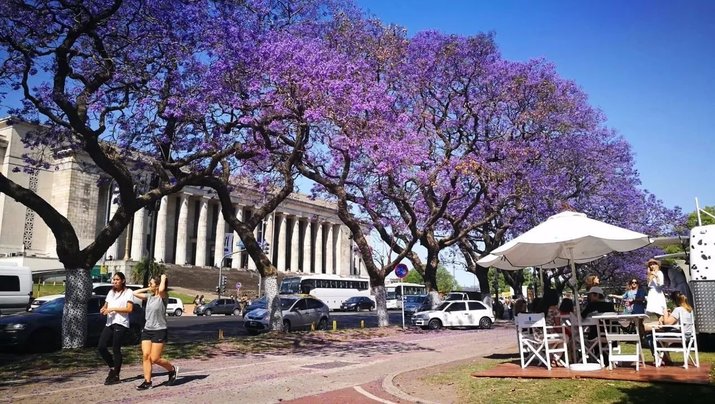 A street in Argentina lined with Jacaranda trees
A street in Argentina lined with Jacaranda trees
Further reading:
Kunming in Bloom: Kunming has cherry blossoms too in spring!
Yunnan's Precious Flowers: some of Yunnan's native flower species
Rapeseed blossom: in February Yunnan turns yellow as fields full of canola flowers bloom extensively
Summer: the Lotus Season: in summer you can see lotus flowering all over Yunnan
- 361 reads
- Like this






